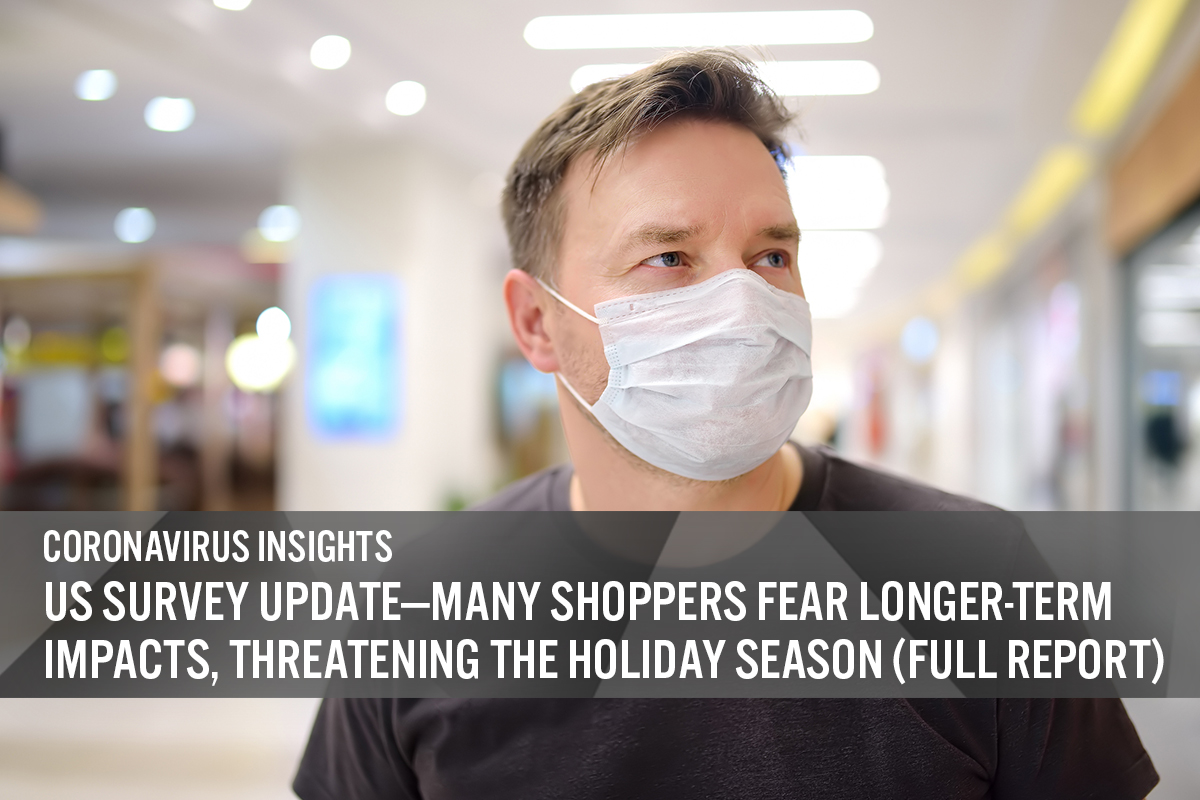
DIpil Das
Introduction
This report presents the results of Coresight Research’s latest weekly survey of US consumers on the coronavirus outbreak, undertaken on April 8. This report explores the trends we are seeing from week to week, following prior surveys on April 1, March 25 and March 17–18. We also compare selected metrics to our late-February consumer survey.Almost Two-Thirds of Consumers Are Now Buying Less
We recorded some volatility in behavior this week, including in buying more of certain categories: The proportion of consumers making more purchases of certain products jumped by almost 25 percentage points in just one week, supported by double-digit percentage-point increases in the number buying more food, personal care products, household products and health products. We also saw increases in the proportion of consumers saying they are buying more of discretionary categories such as apparel and furniture, although the percentage spending more on these types of products remains small (more on specific categories later). Meanwhile, we saw a near-15-percentage-point increase in the proportion of respondents buying fewer of some products, taking the total to almost two-thirds. As we show later, we again saw a big increase in the proportion saying they are buying less apparel.- Note that buying more of certain categories and buying less of certain categories were not mutually exclusive options, so respondents could answer yes to both.
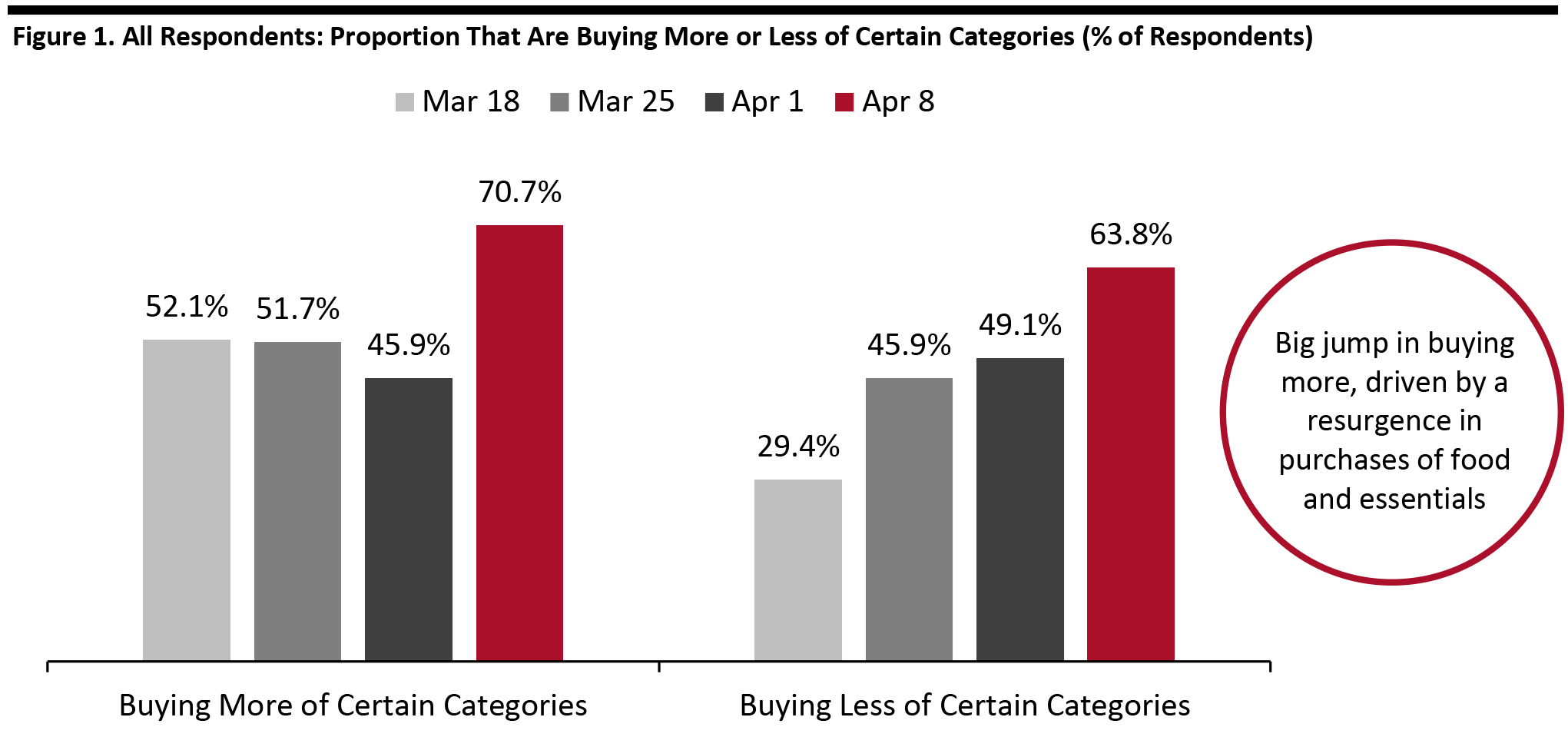 Not all week-over-week differences charted in this report are statistically significant
Not all week-over-week differences charted in this report are statistically significant Base: US Internet users aged 18+
Source: Coresight Research [/caption] When They Expect Their Spending To Return to Normal This week, we asked those respondents who are spending more or spending less when they expect their spending to return to normal levels. Fully 70% of this group expect this only to be the case in three months’ time or more. In addition, almost one in five (18.5%) think it will take six months or more—which takes us up to the holiday season. In the chart below, we break out those who said they are buying certain products less—however, the pattern is broadly the same for these consumers as for all those who have changed their purchasing habits.
- We also asked respondents how long they think the severe impacts of the crisis will last; see later for findings.
 Base: US Internet users aged 18+ who are purchasing any products more or less, because of the coronavirus outbreak
Base: US Internet users aged 18+ who are purchasing any products more or less, because of the coronavirus outbreak Source: Coresight Research [/caption]
What They Are Purchasing More or Less
More: Shoppers continue to buy more nondiscretionary or essential categories such as food, everyday household products, personal care and health products, and this week, we saw meaningful increases in the proportion buying these categories. While still modest in number, we saw week-over-week increases in the proportion of respondents buying more in discretionary categories such as clothing and footwear, beauty products or furniture/home categories (see week-over-week comparisons in Figure 4). Less: Almost 40% of consumers are now cutting apparel purchases, up from around 32% last week. Beauty products and furnishings/home-improvement categories also continue to see large—and growing—cutbacks. Ratio of less to more: The ratio of those purchasing less to those purchasing more eased in some categories this week. Clothing and footwear saw the greatest proportional disparity between buying less/more, with almost six times as many respondents answering “less” as answering “more”—down from a ratio of eight-to-one last week. Furniture/home and electronics/appliances each saw a ratio of around five less to one more this week—versus last week’s ratios of 12-to-one for furniture/home and four-to-one for electronics/appliances. [caption id="attachment_107606" align="aligncenter" width="700"]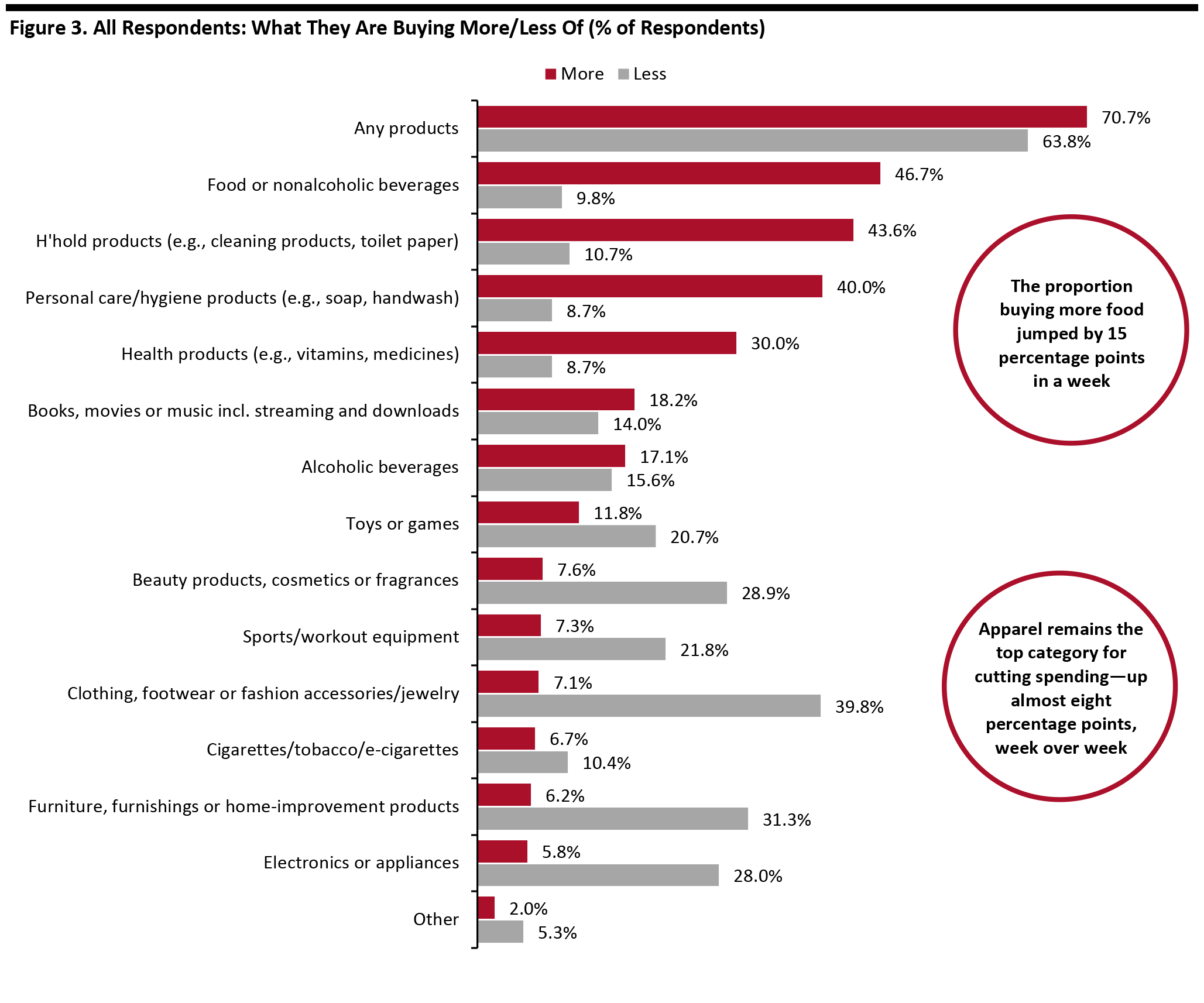 Respondents could select multiple options
Respondents could select multiple options Base: US Internet users aged 18+
Source: Coresight Research [/caption]
Some Shoppers Are Returning to Discretionary Categories—But in Modest Numbers
Apparel, beauty and home categories continue to see a week-over-week deepening in the proportion of respondents cutting back. However, this has started to be partly offset by increases in the proportion increasing their purchases—as we noted above, this resulted in a fall in the “less-to-more” ratio this week. The 39.8% cutting purchases of apparel this week was a near-eight-percentage-point increase from last week, while the percentage buying more apparel virtually doubled to 7.1%. We had previously seen an easing in the number that were purchasing more food, but this week, that number jumped by 15 percentage points—one of a number of volatile metrics we recorded this week. [caption id="attachment_107607" align="aligncenter" width="700"] Base: US Internet users aged 18+
Base: US Internet users aged 18+ Source: Coresight Research [/caption]
Six in 10 Are Switching Spending Online
Almost six in 10 consumers are making more purchases online than before the outbreak—up by almost 11 percentage points in the space of one week. [caption id="attachment_107608" align="aligncenter" width="700"] Base: US Internet users aged 18+
Base: US Internet users aged 18+ Source: Coresight Research [/caption] What They Are Buying More Of Online Nonfood staples such as household products have a clear lead online—even over food and beverages. Food’s third position contrasts with its number-one place for buying more overall, as shown earlier. This could reflect shopper difficulties in obtaining online grocery services due to capacity constraints, or ingrained consumer resistance to buying food items online (keep an eye out for our forthcoming annual online grocery survey report). One in five of those who are buying more products online are buying more apparel on the Internet. That equates to just 11.3% of all respondents—which compares unfavorably to the 39.8% that are cutting apparel spend overall, noted above, and confirms low levels of sales transfer from stores to e-commerce. This week, those making more purchases online were buying on average 3.1 categories more online than they used to, up from 2.7 in last week’s survey. Younger adults are buying more apparel online: Among those making more purchases online, 26% of respondents aged 18–29 are buying more clothing or footwear on the Internet, versus 20.5% of 30–44 year olds, 14% of 45–60 year olds and 12% of those aged over 60. Older consumers are more likely than younger shoppers to be buying health products or books, movies or music more online.
- Note, the percentages below are of those expecting to buy more online.
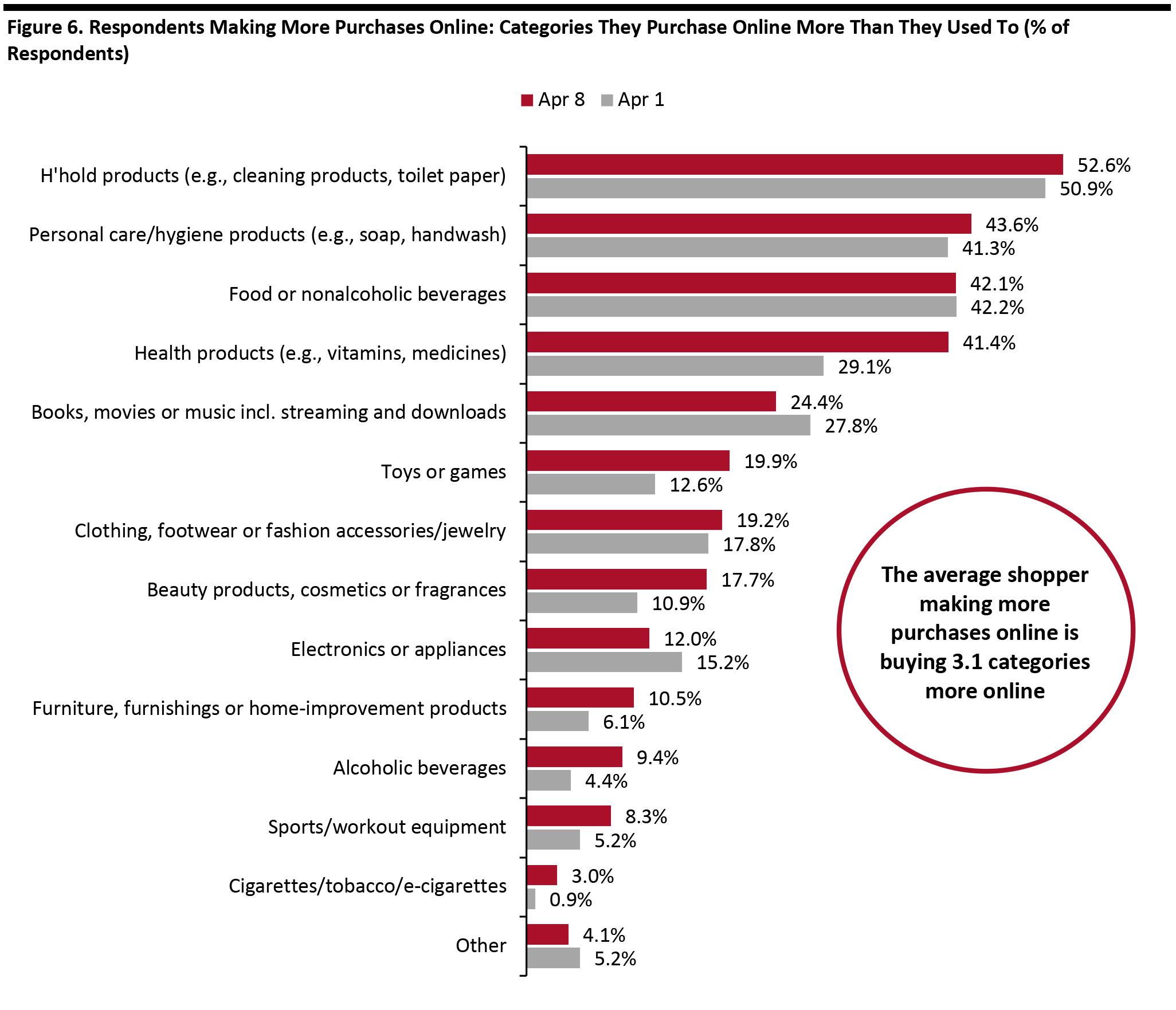 Respondents could select multiple options
Respondents could select multiple options Base: US Internet users aged 18+ who make more purchases online than they did before the coronavirus outbreak
Source: Coresight Research [/caption]
Almost One-Quarter of Consumers Expect the Crisis To Last More Than Six Months
Consumers’ expectations of the length of the crisis continue to increase. This week, almost 22% said they expect the severe impact of the outbreak to last more than six months from its start—which would imply the severe impacts running into the holiday season. Fully 78% now expect the severe impact to last three months or more, up from 74% last week. [caption id="attachment_107610" align="aligncenter" width="700"]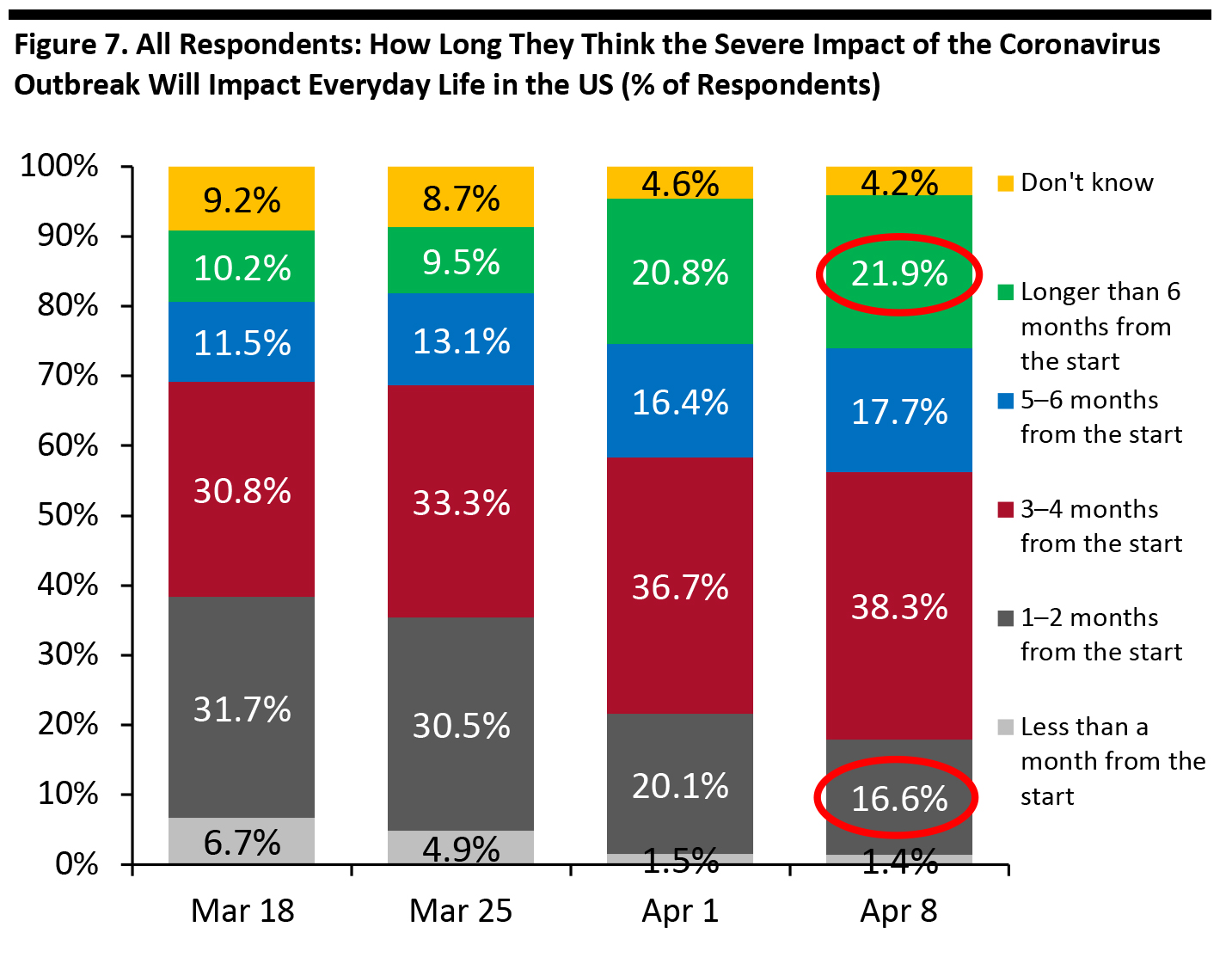 Base: US Internet users aged 18+
Base: US Internet users aged 18+ Source: Coresight Research [/caption]
Most Consumers Are Very Worried
This week, 53.1% of respondents said they are extremely concerned about the outbreak, up only very slightly from last week. A total of 88% of respondents are now either somewhat or extremely concerned about the coronavirus, versus 89% a week earlier. Younger consumers tend to be less worried: This week, only 39% of 18–29 year olds were extremely concerned, versus 53% of 30–44 year olds, 63% of 45–60 year olds and 62% of those aged over 60. Lower levels of concern among younger consumers are in spite of this age group being among the hardest hit by job cuts (see later). [caption id="attachment_107611" align="aligncenter" width="700"] Base: US Internet users aged 18+
Base: US Internet users aged 18+ Source: Coresight Research [/caption] This week, health concerns abated, but they remained the top worry. We saw economic concerns remain level with last week and employment concerns were broadly level (within the margin of error). Most of the concerns listed saw a decline this week. This overall trend can be attributed to respondents selecting slightly fewer items of concern this week; the average respondent noted 2.7 concerns this week versus 2.8 last week. [caption id="attachment_107625" align="aligncenter" width="700"]
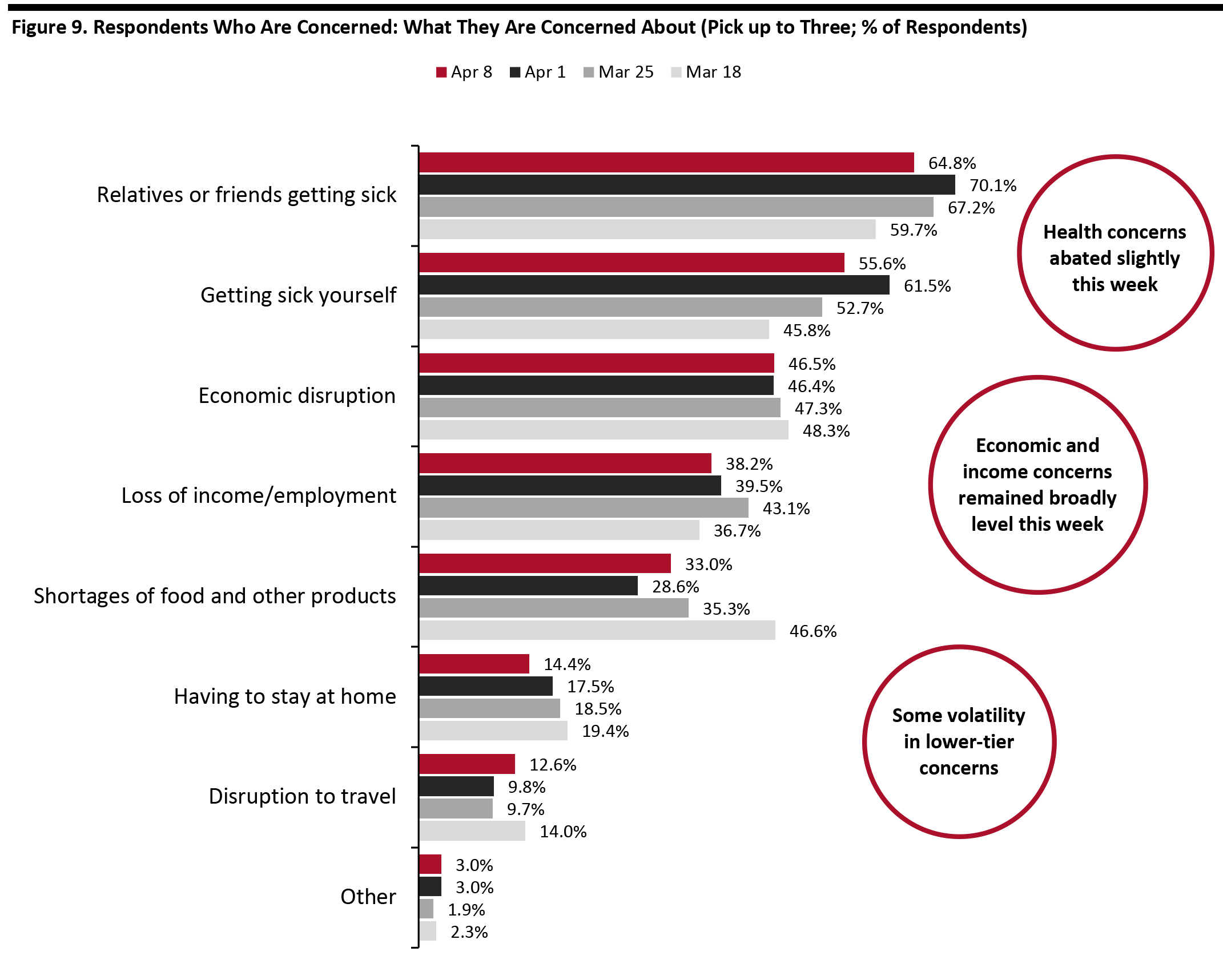 Respondents could select up to three options Base: US Internet users aged 18+ who are concerned about the coronavirus outbreak
Respondents could select up to three options Base: US Internet users aged 18+ who are concerned about the coronavirus outbreak Source: Coresight Research [/caption]
One in Seven Has Lost Their Job
We asked respondents to choose from a selection of statements related to employment and income. Just under one in seven respondents (13.6%) now say they have lost their job, up from one in 10 last week. By age, around 15% of the 18–29 age group say they have already lost their job, versus 15.5% of those aged 30–44, 12% of those aged 45–60 and just under 10% of those aged over 60. This week, a total of around 40% were worried about losing their job or part of their income, down from 41% last week. We have seen this combined total steadily decline from a peak of just over 46% on March 18—possibly because some of those who were most worried have since lost their jobs. [caption id="attachment_107626" align="aligncenter" width="700"]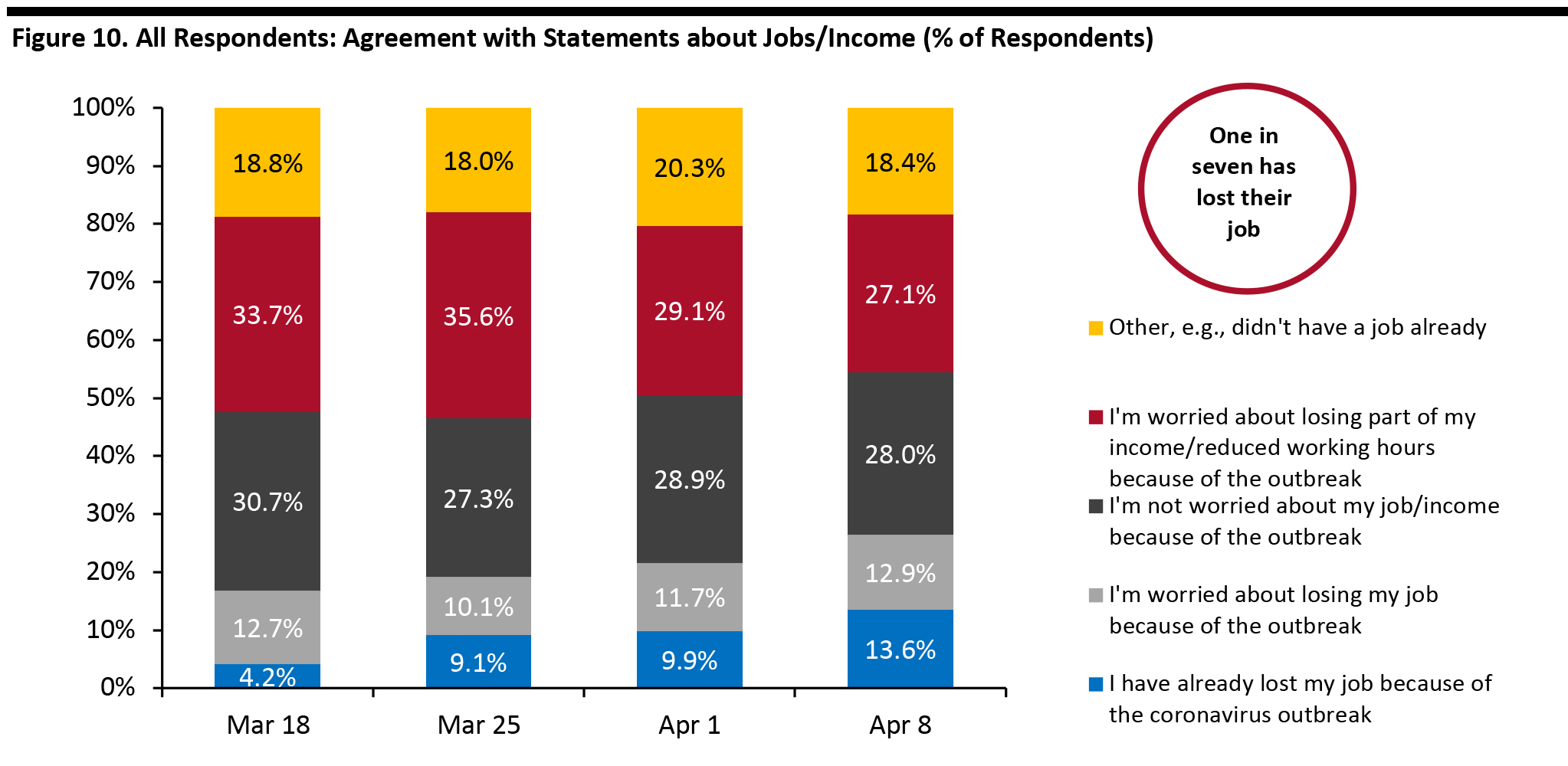 Base: US Internet users aged 18+
Base: US Internet users aged 18+ Source: Coresight Research [/caption]
Almost All Consumers Now Taking Avoidance Actions
Avoidance action is now virtually universal, with 96% of respondents avoiding public places or not travelling. [caption id="attachment_107614" align="aligncenter" width="700"] Base: Internet users aged 18+
Base: Internet users aged 18+ Source: Coresight Research [/caption] This week, around 83% of respondents said they avoided food-service businesses and 80% avoided shopping centers. [caption id="attachment_107615" align="aligncenter" width="700"]
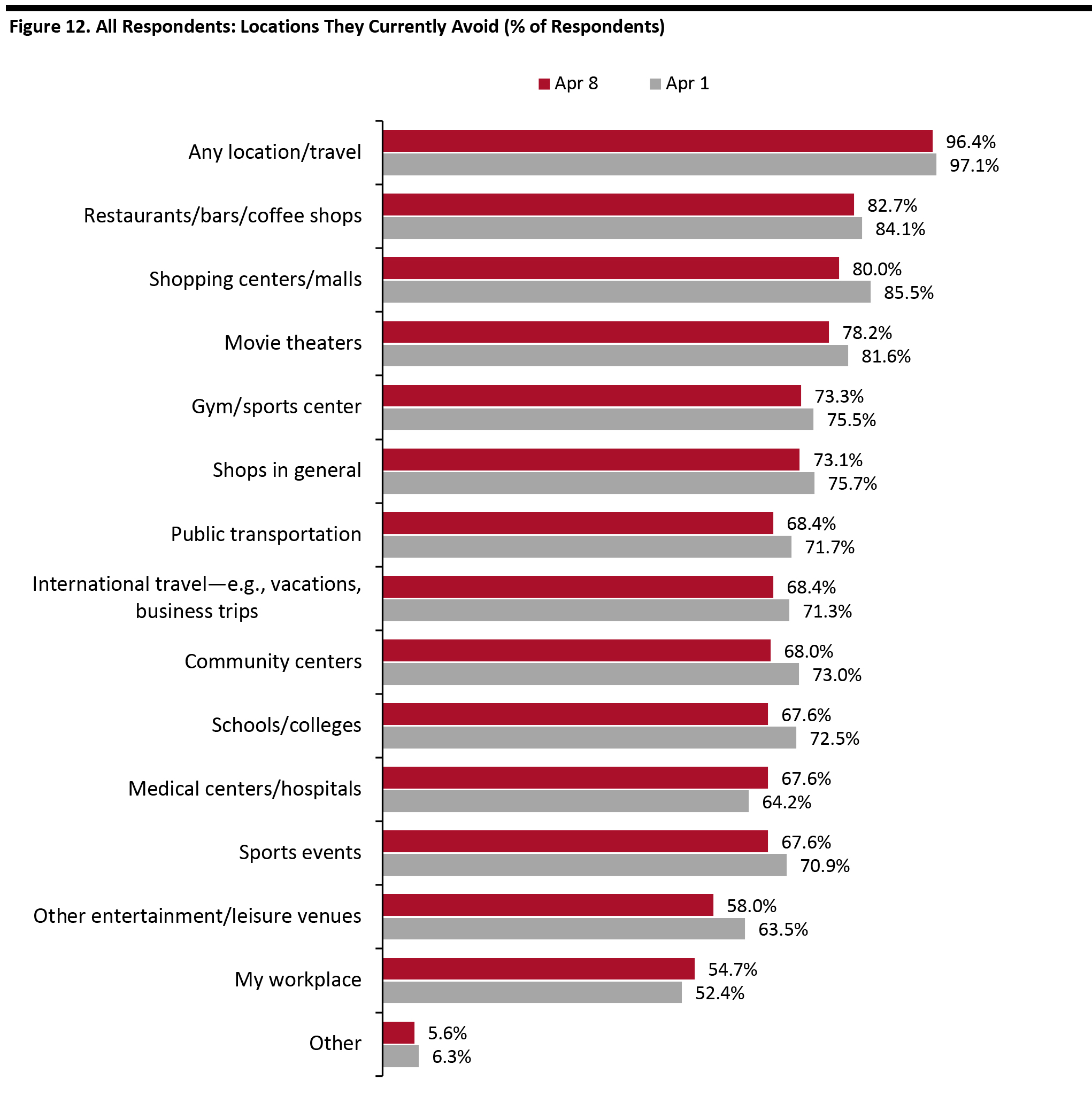 Respondents could select multiple options
Respondents could select multiple options Base: US Internet users aged 18+
Source: Coresight Research [/caption]
Around Two-Thirds Expect To Retain Changes in Behavior
Each week, we ask respondents if they will retain changed behaviors after the crisis ends. This week, we saw a further increase in those expecting to do so, to around two-thirds. [caption id="attachment_107616" align="aligncenter" width="700"]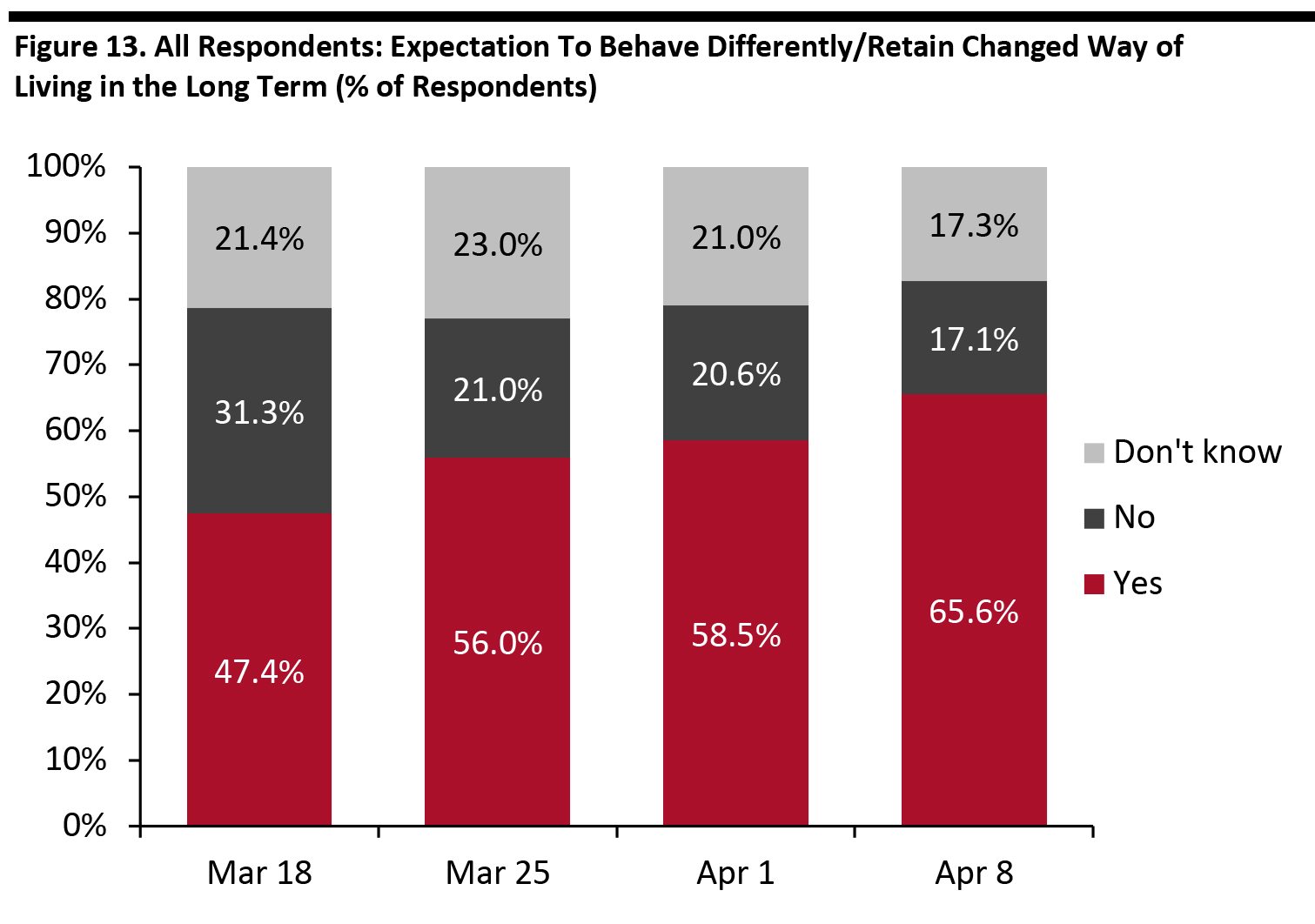 Base: US Internet users aged 18+
Base: US Internet users aged 18+ Source: Coresight Research [/caption] Among those who expect to keep outbreak-driven behavior, prevention through better hygiene was the top behavior, consistent with prior weeks. However, the proportion selecting these top concerns is dwindling. Meanwhile, we have seen consistent increases in the proportion of respondents expecting to switch retail purchases from stores to e-commerce and a less significant increase in those expecting to shop less. This week, almost 36% of those expecting to retain changed behaviors anticipate buying more online and less in stores—representing around 24% of all respondents (including those not expecting to retain changed behaviors), up sharply from 19% of all respondents last week.
- Note, the percentages below are of those people who expect to retain changed behaviors.
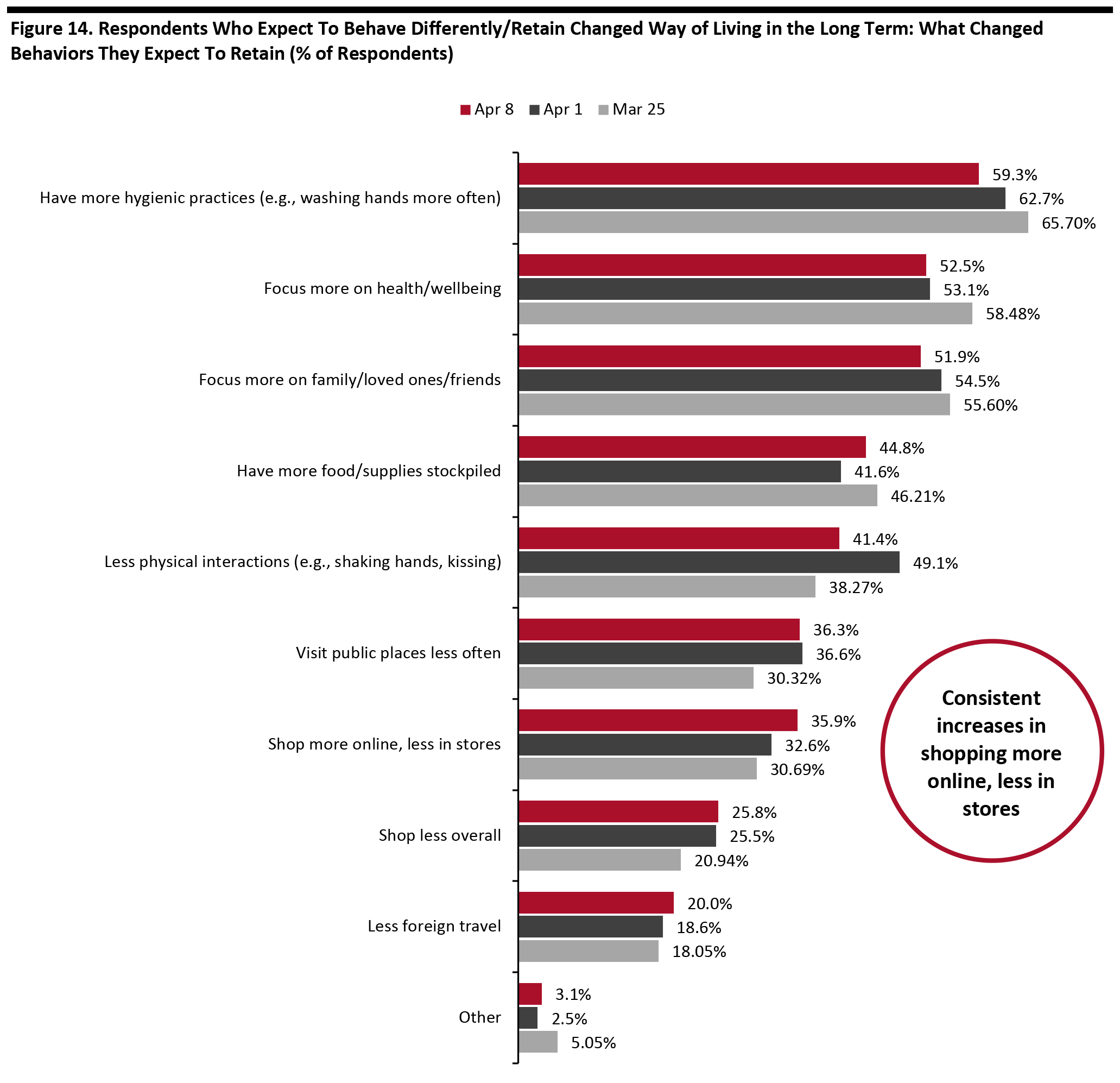 Respondents could select multiple options
Respondents could select multiple options Base: US Internet users aged 18+ who expect to behave differently in the long term/retain changed ways of living from the outbreak
Source: Coresight Research [/caption]